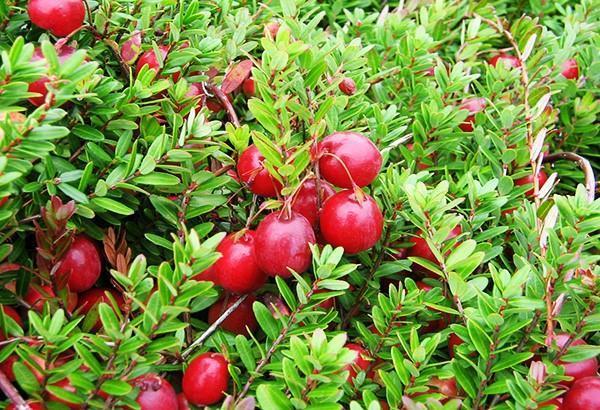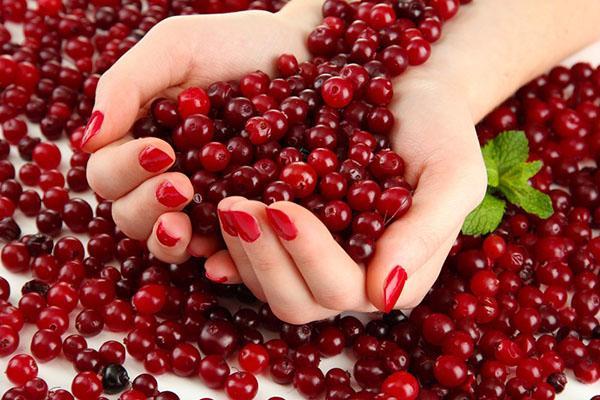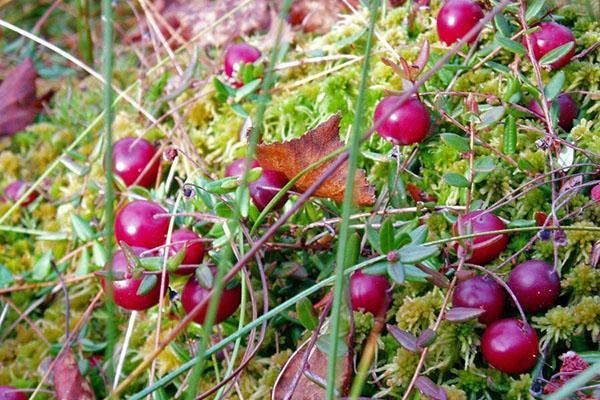A close acquaintance with cranberries - where it grows and how to collect it
 Among the many types of berries that nature gave people, one of the most useful is cranberries. But, despite this, not everyone knows where cranberries grow, and what vitamins it contains. This is an amazing wild berry that is used not only as food, but also for the treatment of many diseases. Knowing information about the plant, you can significantly improve your health and have an attractive appearance.
Among the many types of berries that nature gave people, one of the most useful is cranberries. But, despite this, not everyone knows where cranberries grow, and what vitamins it contains. This is an amazing wild berry that is used not only as food, but also for the treatment of many diseases. Knowing information about the plant, you can significantly improve your health and have an attractive appearance.
A berry that gives people beauty and health

The main types of plants:
- ordinary;

- small-fruited;

- large-fruited.

Only the first and second species grow on the territory of the Russian Federation. Common cranberries are found throughout the country. The exception is the Volga region, Kuban, Caucasus.
Shallow water can be observed in the Tundra and northern swamps.
As for the large-fruited, its homeland is the land near the Appalachian mountains.
The berries contain about 15% ascorbic acid.
The berry is popular not only for its set of vitamins, but also for its calorie content. In fact, fresh cranberries are part of the diet. As for dried food, you have to be extremely careful with it, since there are about 300 Kcal in 100 grams.
 Vitamins found in cranberries:
Vitamins found in cranberries:
- pectin;
- betaine;
- catechins;
- various acids and others.
The main vitamin, the largest percentage of which is found in cranberries, is ascorbic acid. Even citrus fruits bypassed in its quantity. Also, the beak is rich in vitamins E and B. According to the studies carried out, a large amount of phosphorus and calcium was found in the pulp, which are essential for the proper development of the body.
What diseases does cranberry cure?
 The varieties that prefer to grow in swamps are renowned for their mineral composition. They contain almost the entire set of the periodic table.
The varieties that prefer to grow in swamps are renowned for their mineral composition. They contain almost the entire set of the periodic table.
Freshly squeezed juice helps to strengthen the immune system.
Frequent consumption of cranberry berries contributes to:
- Improved appetite. Fresh fruits help to increase the production of gastric juice and keep the digestive system working. Often, marsh cranberries are prescribed for pathologies of the pancreas.

- Restoration of the genitourinary system. It has a diuretic effect and also helps to get rid of disease-causing bacteria.

- Slowing down the inflammatory process. Fresh berry juice has also been shown to help prevent the development of malignant tumors. This action is especially directed to the area of the intestines, prostate and young glands.
- Restoration of blood cholesterol levels. Berries have a positive effect on blood vessels. They improve the functioning of the cardiovascular system, as well as help get rid of headaches. Frequent consumption of cranberries is a good prevention of atherosclerosis and stroke.

- Removal of harmful flora. The berries have anthelmintic properties.

Also fresh cranberries are a way to refresh and invigorate. She has good antipyretic properties. Because of this, the fruit is often prescribed by doctors for respiratory diseases and flu.
Peculiarity of marsh cranberry
 This species grows in the form of bushes. Their uniqueness is that the plants remain green throughout the year. They do not change their color even with the onset of winter.
This species grows in the form of bushes. Their uniqueness is that the plants remain green throughout the year. They do not change their color even with the onset of winter.
Bushes cranberries marsh have a low height. The stem is thin, like a thread. In young plants, the branches are abundantly covered with small villi. Shoots often cover the ground, but sometimes they can be slightly raised up.
Deciduous plates are small. They are attached to the same small green petioles. Their shape resembles an egg with a slightly pointed tip and curved edges. The upper part of the leaves is glossy, rich green, and the lower is grayish.
 The flowers of this bush are small. Often the buds in the opened form have a purple hue, but there are also snow-white. The flowers are drooping.
The flowers of this bush are small. Often the buds in the opened form have a purple hue, but there are also snow-white. The flowers are drooping.
In their place, berries appear, which have a spherical shape. Their diameter reaches from 1 to 1.5 cm. Green fruits are white, but after a while they become saturated red.
To make the berries as healthy and tasty as possible, you should know not only when to pick cranberries, but also how to store them.
The first flowering of this wonderful plant can be observed from spring to early summer. But despite this early, the fruits are formed from the beginning of September to November. It is at this time that the main harvest takes place.
 As for frosts, they are not terrible for the fruits of the plant. Even in severe frosts, the berries retain their benefits and appearance. So when the cranberries overwintered under the snow, they are often called snowy.
As for frosts, they are not terrible for the fruits of the plant. Even in severe frosts, the berries retain their benefits and appearance. So when the cranberries overwintered under the snow, they are often called snowy.
The "hunt" for berries has been carried out since ancient times. Those who collect fruits annually know all the nuances and features of this process. It will be, of course, more difficult for beginners, since you need to be vigilant and not fall into the "trap" of swamp slurry.
Garden cranberries: cultivation and benefits
 There are several varieties of this type of plant. They are all different from each other. Most of them grow only on highly acidic lands. Among the many species, there are those that can be grown on your site.
There are several varieties of this type of plant. They are all different from each other. Most of them grow only on highly acidic lands. Among the many species, there are those that can be grown on your site.
Many people do not know what such cranberries look like and how to properly care for them. This plant has the shape of a bush. The maximum height that it can reach is within 80 cm. The stems of such cranberries can be raised, erect and creeping. Shoots that are located on the surface of the earth grow up to 1 meter long, and erect up to 15 cm.
 Garden cranberries grow, like wild ones. Its root system is underdeveloped, superficial. This allows the plant to better absorb nutrients from the soil. Flowers of pinkish tint. They form racemose inflorescences. The buds appear in May. Flowering can last until the end of June. Fruits are bright red. They all have juicy and incredibly healthy pulp.
Garden cranberries grow, like wild ones. Its root system is underdeveloped, superficial. This allows the plant to better absorb nutrients from the soil. Flowers of pinkish tint. They form racemose inflorescences. The buds appear in May. Flowering can last until the end of June. Fruits are bright red. They all have juicy and incredibly healthy pulp.
 Ripe garden cranberries differ slightly in size. If the plant is properly looked after, then the fruits can grow up to 2 cm in diameter. They have a sour aftertaste with 6 to 30 grains in the middle. The seeds are small.
Ripe garden cranberries differ slightly in size. If the plant is properly looked after, then the fruits can grow up to 2 cm in diameter. They have a sour aftertaste with 6 to 30 grains in the middle. The seeds are small.
Berries of garden species are rich in:
- fructose and glucose;
- vitamin C;
- citric acid;
- rather rare vitamin P;
- tanning components;
- iodine;
- silver;
- copper.
Due to the sour taste of the berries, they are often called "northern lemons". Due to the fact that many organic acids are present in the composition, they do not lend themselves to the development of fungi and bacteria that can spoil the structure of the fruit.
Garden cranberries are harvested from September to October. Due to the fact that the berries contain a significant amount of benzoic acid, they feel great in frosts and under a large ball of snow. Such bushes grow up to 60 years. Sometimes this figure may even increase. The first harvest of garden cranberries can be observed in the third or fourth year after planting.
Because how well the site will be prepared, the rooting of the seedling depends.
You can propagate a plant:
- seeds;
- cuttings.
Seeds. This breeding method is rarely used. It is often used for breeding experiments. This is due to the fact that the plants that are obtained in this way have practically no signs of their parents.
Cuttings. It is necessary to separate parts of the shoots only when they are actively growing. The optimum cutting length should be at least 10 centimeters. They are planted in containers with a peat mixture or directly to the main place.
They should be deepened to a depth of about two centimeters. After planting, compact and moisturize the soil around each seedling. In order for the plant to quickly begin, it is necessary to carefully monitor the condition of the soil. The ground must be constantly moist. If the planting is carried out correctly, then in a few years the bushes will delight with their first incredibly healthy berries.
For everyone who wants to enrich their body with a set of useful microelements, cranberries are the best option. Knowing where it can be collected in Russia will allow you to stock up on these amazing berries for the whole winter.